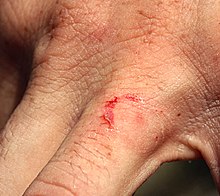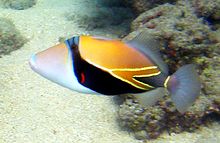This is an old revision of this page, as edited by Divingpetrel (talk | contribs) at 18:35, 16 November 2012. The present address (URL) is a permanent link to this revision, which may differ significantly from the current revision.
Revision as of 18:35, 16 November 2012 by Divingpetrel (talk | contribs)(diff) ← Previous revision | Latest revision (diff) | Newer revision → (diff) For the surveillance technology, see Triggerfish (surveillance).
| Triggerfish Temporal range: Miocene - recent | |
|---|---|

| |
| Picasso or lagoon triggerfish (Rhinecanthus aculeatus) | |
| Scientific classification | |
| Kingdom: | Animalia |
| Phylum: | Chordata |
| Class: | Actinopterygii |
| Order: | Tetraodontiformes |
| Family: | Balistidae A. Risso, 1810 |
| Genera | |
|
12, see text. | |
Triggerfishes are about 40 species of often brightly colored fishes of the family Balistidae. Often marked by lines and spots, they inhabit tropical and subtropical oceans throughout the world, with the greatest species richness in the Indo-Pacific. Most are found in relatively shallow, coastal habitats, especially at coral reefs, but a few, such as the aptly named oceanic triggerfish (Canthidermis maculata), are pelagic. While several species from this family are popular in the marine aquarium trade, they are often notoriously ill-tempered.
Anatomy and appearance

The largest member of the family, the stone triggerfish (Pseudobalistes naufragium) reaches 1 metre (3.3 ft), but most species have a maximum length between 20 and 50 centimetres (7.9 and 19.7 in).
Triggerfish have an oval shaped, highly compressed body. The head is large, terminating in a small but strong- jawed mouth with teeth adapted for crushing shells. The eyes are small, set far back from the mouth, at the top of the head. The anterior dorsal fin is reduced to a set of three spines. The first spine is stout and by far the longest. All three are normally retracted into a groove. The ventral and the posterior dorsal fins are capable of undulating from side to side to provide slow speed movement. The sickle shaped caudal fin is used only to escape predators.

The two pelvic fins are overlaid by skin for most of their length and fused to form a single spine, terminated by very short rays, their only external evidence. Gill plates operculum too, although present are not visible, overlaid by the tough skin, covered with rough, rhomboid scales, that forms a stout armor on their body. The only gill opening is a vertical slit, directly above the pectoral fins. This peculiar covering of the gill plates is shared with other members of the Tetradontae order. Each jaw contains a row of four teeth on either side, while the upper jaw contains an additional set of six plate-like pharingeal teeth.
As a protection against predators, triggerfish can erect the first two dorsal spines: The first, (anterior) spine is locked in place by erection of the short second spine, and can be unlocked only by depressing the second, “trigger” spine, hence the family name “triggerfish”.
With the exception of a few species from the genus Xanthichthys, the sexes of all species in this family are similar in appearance.
Behavior

The rather bizarre anatomy of the triggerfishes reflects their typical diet of slow-moving, bottom dwelling crustaceans, mollusks, sea urchins and other echinoderms, generally creatures with protective shells and spines. Many will also take small fishes and some, notably the members of the genus Melichthys, feed on algae. A few, for example the redtoothed triggerfish (Odonus niger), mainly feed on plankton. They are known to exhibit a level of intelligence that is unusual among fishes, and have the ability to learn from previous experiences.

Some triggerfish species can be quite aggressive when guarding their eggs. Both the picasso (Rhinecanthus aculeatus) and titan triggerfish (Balistoides viridescens) viciously defend their nests against intruders, including scuba divers and snorkelers. Their territory extends in a cone from the nest toward the surface, so swimming upwards can put a diver further into the fishes' territory; a horizontal swim away from the nest site is best when confronted by an angry triggerfish. Unlike the relatively small picasso triggerfish, the titan triggerfish poses a serious threat to inattentive divers due to its large size and powerful teeth.
Triggerfish are notorious bait stealers; rather than swallowing a bait whole, they nibble off small bites of it, making a small, stout hook essential to success in hooking them. Accordingly, the best baits are tough strips of fish skin, squid mantle etc.
Life history

Triggerfish lay their demersal eggs in a small hole dug in the sea bottom. Off Florida, juveniles of some species of triggerfishes are found in floating sargassum, where they feed on the small shrimp, crabs and molluscs found there.
Edibility
Some species of triggerfish, such as the titan triggerfish, may be ciguatoxic and should be avoided. Others, such as the gray triggerfish (Balistes capriscus), are excellent table-fare.
Genera and species
- Abalistes Bloch & Schneider, 1801
- Abalistes filamentosus Matsuura & Yoshino, 2004
- Abalistes stellaris (Bloch & Schneider, 1801) (Starry triggerfish)
- Abalistes stellatus (Anonymous - referred to Lacépède, 1798)

- Balistapus Tilesius, 1820
- Balistapus undulatus (Park, 1797) (Orange-lined triggerfish)
- Balistes Linnaeus, 1758
- Balistes capriscus J. F. Gmelin, 1789 (Grey triggerfish)
- Balistes ellioti Day, 1889
- Balistes polylepis Steindachner, 1876 (Finescale triggerfish)
- Balistes punctatus J. F. Gmelin, 1789 (Bluespotted triggerfish)
- Balistes rotundatus Marion de Procé, 1822
- Balistes vetula Linnaeus, 1758 (Queen triggerfish)
- Balistes willughbeii Lay & Bennett, 1839
- Balistoides Fraser-Brunner, 1935
- Balistoides conspicillum (Bloch & Schneider, 1801) (Clown triggerfish)
- Balistoides viridescens (Bloch & Schneider, 1801) (Titan triggerfish)

- Canthidermis Swainson, 1839
- Canthidermis macrolepis (Boulenger, 1888) (Large-scale triggerfish)
- Canthidermis maculata (Bloch, 1786) (Ocean triggerfish)
- Canthidermis sufflamen (Mitchill, 1815)
- Melichthys Swainson, 1839
- Melichthys indicus Randall & Klausewitz, 1973 (Indian triggerfish)
- Melichthys niger (Bloch, 1786) (Black triggerfish)
- Melichthys vidua (J. Richardson, 1845) (Pinktail triggerfish)
- Odonus Gistel, 1848
- Odonus niger (Rüppell, 1836) (Redtooth Trigger)
- Pseudobalistes Bleeker, 1865
- Pseudobalistes flavomarginatus (Rüppell, 1829) (Yellowmargin triggerfish)
- Pseudobalistes fuscus (Bloch & Schneider, 1801) (yellow-spotted triggerfish)
- Pseudobalistes naufragium (Jordan & Starks, 1895) (Stone triggerfish)

- Rhinecanthus Swainson, 1839
- Rhinecanthus abyssus Matsuura & Shiobara, 1989
- Rhinecanthus aculeatus (Linnaeus, 1758) (White-banded triggerfish)
- Rhinecanthus assasi (Forsskål, 1775) (Picasso triggerfish)
- Rhinecanthus cinereus (Bonnaterre, 1788)
- Rhinecanthus lunula Randall & Steene, 1983 (Halfmoon picassofish)
- Rhinecanthus rectangulus (Bloch & Schneider, 1801) (Wedge-tail triggerfish)
- Rhinecanthus verrucosus (Linnaeus, 1758) (Blackbelly triggerfish)
- Sufflamen Jordan, 1916
- Sufflamen albicaudatum (Rüppell, 1829) (Bluethroat triggerfish)
- Sufflamen bursa (Bloch & Schneider, 1801) (Boomerang triggerfish)
- Sufflamen chrysopterum (Bloch & Schneider, 1801) (Halfmoon triggerfish)
- Sufflamen fraenatum (Latreille, 1804) (Masked triggerfish)
- Sufflamen verres (Gilbert & Starks, 1904) (Orangeside triggerfish)

- Xanthichthys Kaup in Richardson, 1856
- Xanthichthys auromarginatus (Bennett, 1832) (Gilded triggerfish)
- Xanthichthys caeruleolineatus Randall, Matsuura & Zama, 1978 (Outrigger triggerfish)
- Xanthichthys lima (Bennett, 1832)
- Xanthichthys lineopunctatus (Hollard, 1854) (Striped triggerfish)
- Xanthichthys mento (Jordan & Gilbert, 1882) (Redtail triggerfish)
- Xanthichthys ringens (Linnaeus, 1758) (Sargassum triggerfish)
- Xenobalistes Matsuura, 1981
See also
References
- ^ Lieske, E., & R. Myers (1999). Coral Reef Fishes. 2nd edition. Princeton University Press. ISBN 0-691-00481-1
- ^ McDavid, J. (2007). Aquarium Fish: Triggerfish. Advanced Aquarist.
- Froese, Rainer; Pauly, Daniel (eds.). "Pseudobalistes naufragium". FishBase. January 2010 version.
- Debelius, H. (1993). Indian Ocean Tropical Fish Guide. Aquaprint Verlags GmbH. ISBN 3-927991-01-5
- Millington, J. T., & J. E. Randall (1990). Triggerfish bite – a little-known marine hazard. J. Wilderness Medicine 1: 79-85
- Matsura, Keiichi & Tyler, James C. (1998). Paxton, J.R. & Eschmeyer, W.N. (ed.). Encyclopedia of Fishes. San Diego: Academic Press. pp. 228–229. ISBN 0-12-547665-5.
{{cite book}}: CS1 maint: multiple names: authors list (link)
- Froese, Rainer; Pauly, Daniel (eds.). "Family Balistidae". FishBase. February 2011 version.